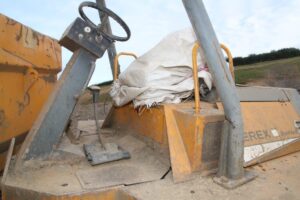HSE’s Science and Research Centre welcomes scientists of the future
Scientists of the future got to see at first hand the excellent work that goes on at the Health and Safety Executive’s (HSE) Science and Research Centre in Buxton.
 A-Level students from Meadowhead School in Sheffield spent time at the specialist facility meeting HSE scientists and hearing from them about their careers, career paths and academic route into science.
A-Level students from Meadowhead School in Sheffield spent time at the specialist facility meeting HSE scientists and hearing from them about their careers, career paths and academic route into science.
The visit, organised by HSE, encourages students to think about science, technology, engineering, and maths (STEM) as a future career.
A group of 21 students started the day with a tour of the wider site, looking at the experimental facilities and test rigs and received an overview of the type of projects and science-based work that has been conducted in Buxton over the years.
Smaller groups of students based on their A-level choices then spent time with relevant specialists including engineers, biochemists, fire and explosives specialists, analytical chemists, human factors specialists, toxicologists, noise and vibration specialists, ventilation specialists, and microbiologists.
Professor Andrew Curran, HSE’s Director of Science, said: “We are very proud of all our facilities and our specialist scientists, engineers and analysts at Buxton and this visit allowed students to speak to our inspirational scientists who were able to showcase some of their work first hand.
 “We hope we’ve helped broaden the students’ views of hands-on science, technology, engineering, and maths by showing them areas of work they may not have considered before and how rewarding a career in STEM can be.
“We hope we’ve helped broaden the students’ views of hands-on science, technology, engineering, and maths by showing them areas of work they may not have considered before and how rewarding a career in STEM can be.
“Visits like this are really important as they can trigger a ‘wow’ moment for a student which inspires them to take a new direction in their career.”
HSE’s Science and Research Centre is set on a 550-acre site in Buxton, Derbyshire, and accommodates an impressive inventory of laboratory and large-scale testing facilities.
Around 380 scientists, engineers, occupational health and hygiene specialists and support professionals are based at the site. Here they provide the research and evidence that HSE requires to underpin its regulatory activities, protect people and places and make Great Britain one of the safest places in the world to work.
 Cerys Evans, careers leader at Meadowhead school and sixth form, added: “Students were keen to find STEM-related work experience, but were struggling to find the right settings within travelling distance, which is where the team at HSE stepped in.
Cerys Evans, careers leader at Meadowhead school and sixth form, added: “Students were keen to find STEM-related work experience, but were struggling to find the right settings within travelling distance, which is where the team at HSE stepped in.
“Students found out about the work carried out at the centre, touring the facilities, hearing from specialists, and finding out more about specific experimental activity linked to biology, chemistry, physics, human factors and engineering.
“Students will then put together a presentation of their experience to be shared with younger students at school. Many thanks to HSE for offering our students this great opportunity to explore STEM careers.”
Notes to editors:
- The Health and Safety Executive (HSE) is Britain’s national regulator for workplace health and safety. We prevent work-related death, injury and ill health through regulatory actions that range from influencing behaviours across whole industry sectors through to targeted interventions on individual businesses. These activities are supported by globally recognised scientific expertise.
- Further details on the latest HSE news releases is available.



